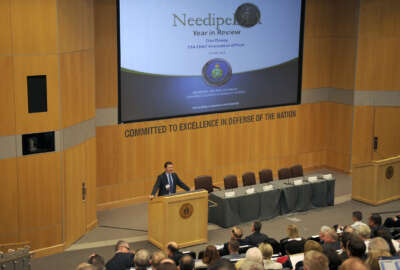
Warp speed, wormholes, invisibility cloaks: Why DIA’s research isn’t a joke
The Federation of American Scientists obtained a copy of a list of 18 science fiction inspired research projects that DIA funded under its Advanced Aerospace Threat...
In Star Trek, Captain of the Enterprise James T. Kirk often spoke those famous words, “Mr. Sulu, take us to warp speed.”
Harry Potter donned the invisibility cloak seven times over the course of those eight best-selling books. And Peter Hamilton’s 2004 book “Pandora’s Star” described how humans harnessed wormhole technology to colonize hundreds of planets in the far-off future.
Warp speed, invisibility cloaks and harnessing the power of wormholes are three of 18 areas of research the Defense Intelligence Agency spent more than $20 million on in the mid-2000s. But before you mock DIA or chalk it up to another example of government squandering money, keep in mind that these movies and books, and hundreds more like them, spark our imagination and make us wonder what the future might actually look like.
That is why the DIA’s projects are so fascinating. The Federation of American Scientists obtained the list of reports from DIA under a Freedom of Information Act (FOIA) request.
DIA paid $22 million between 2007 and 2012 for research under the Advanced Aerospace Threat and Identification Program (AATIP), which many have called former Sen. Harry Reid’s (D-Nev.) UFO pet project.
“At first glance it looks like a pretty wild list of topics. I think that will be most people’s reaction to seeing these things because they do seem sort of far out there. But if you look at it with a little more context about what DIA’s role is and the nature of intelligence more generally, it’s not quite as wild of a list at first glance,” said John Amble, editorial director at the Modern War Institute at West Point. “One of the requirements of intelligence is to do strategic forecasting. If you start looking at strategic intelligence, you are looking generations into the future in some cases and certainly generations in terms of equipment, weapons and platforms.”
Amble said too often DoD is particularly focused on tactical level intelligence, so for DIA to look at weapons and technology that is “far out there” is important.
DIA encourages researchers to dream a little
August Cole, a non-resident senior fellow at the Atlantic Council and co-author of “Ghost Fleet,” went even further, saying it’s critical for DoD, military researchers and contractors to “dream a little bit” to overcome traditional blind-spots in planning.

“I think this list accurately reflects what the future of war forecast might look like,” Cole said. “It’s easy to dismiss the research that they were undertaking and exploring, but the reality is the speed at which war is moving is going to require the kind of technical solutions from the lasers we see today becoming more operational to invisibility cloaks that an individual solider could wear or could be applied to an aircraft like the F-22.”
Cole and Amble say DIA — or any agency for that matter — funding this type of research is critical to opening up some potential innovations.
Cole said science fiction books from 100 years ago were filled with all kinds of concepts and ideas that became reality today like the machine gun, the rocket and, probably the most famous one, lasers.
“The reality is this shows the seriousness of which technology innovation needs to be treated,” he said. “It puts you in a paradox where you want to be creative and thinking through the potential rule breaking innovations that are out there that could upend the sorts of assumptions about what it means to fight a war in the same way just like a breakthrough like a machine gun, the airplane and the long-range rocket did. So we are in this position where you both need to have a loose free-wheeling style imagination mining everything from science fiction literature to kinds of traditional foresight activities, and then figuring out how to make it real.”
It’s not surprising that DIA and Reid’s decision to spend taxpayer money on these topics doesn’t sit well with everyone.
Whimsical at best, frivolous at worst
Steve Aftergood, the director of the Project on Government Secrecy at the FAS, said his first reaction to seeing DIA’s list was a little bit of anger based on the nature of the research.
Related Stories
Aftergood, however, said he sees the value in supporting unconventional thinking on a small scale. And $22 million on this type of research is relatively small compared to the federal research and development budget of $117 billion a year.
“They would say we are willing to be ridiculous if it means we can support someone with a vision who is really doing some far looking into future and telling us things we wouldn’t have through by ourselves,” he said. “If 99 percent of this work results in work that is junk, but if 1 percent is brilliant, then all of it is money well spent.”
And it’s that 1 percent that DoD is counting on as it must invest in the “whimsical,” must explore books and movies in the science fiction realm and must enter the worlds of Isaac Asimov and other inspiration pioneers to prepare for the next 100 years.
In fact, Cole said there are few items on DIA’s research list that may be more relevant in next 10-to-20 years, such as hyper-sonic tracking, which is a capability the Chinese, Russians and U.S. are all working on.
“These things are never simple solutions. The farther you reach, the more difficult it’s going to be whether it’s exploring the kind of meta materials that are out there today or going back to the concepts of cloaking or lasers. But at same time if you don’t attempt to explore the sorts of technology that look like they belong on a sci-fi wish list, you can be sure your adversary will be,” Cole said. “So this competitive aspect to innovation can’t be forgotten when considering a list of programs like this that looks like a potential, fantastical boondoggle but in fact may be more militarily relevant than you realize.”
Read more of the Reporter’s Notebook
Copyright © 2025 Federal News Network. All rights reserved. This website is not intended for users located within the European Economic Area.
Jason Miller is executive editor of Federal News Network and directs news coverage on the people, policy and programs of the federal government.
Follow @jmillerWFED





